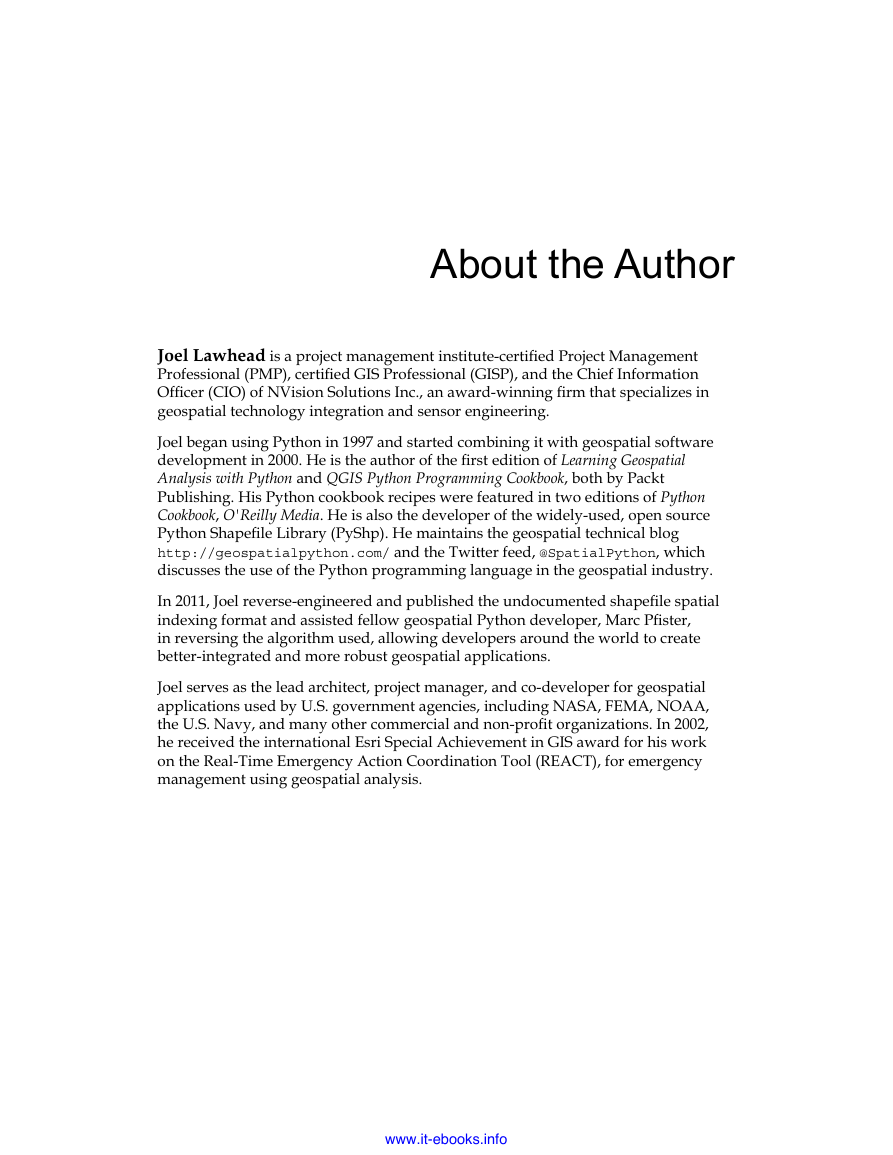Cover
Copyright
Credits
About the Author
About the Reviewers
www.PacktPub.com
Table of Contents
Preface
Chapter 1: Learning Geospatial Analysis with Python
Geospatial analysis and our world
Beyond disasters
History of geospatial analysis
Geographic information systems
Remote sensing
Elevation data
Computer-aided drafting
Geospatial analysis and computer programming
Object-oriented programming for geospatial analysis
Importance of geospatial analysis
Geographic information system concepts
Thematic maps
Spatial databases
Spatial indexing
Metadata
Map projections
Rendering
Remote sensing concepts
Images as data
Remote sensing and color
Common vector GIS concepts
Data structures
Buffer
Dissolve
Generalize
Intersection
Merge
Point in polygon
Union
Join
Geospatial rules about polygons
Common raster data concepts
Band math
Change detection
Histogram
Feature extraction
Supervised classification
Unsupervised classification
Creating the simplest possible Python GIS
Getting started with Python
Building SimpleGIS
Step by step
Summary
Chapter 2: Geospatial Data
An overview of common data formats
Data structures
Common traits
Geolocation
Subject information
Spatial indexing
Indexing algorithms
Quadtree index
R-tree index
Grids
Overviews
Metadata
File structure
Vector data
Shapefiles
CAD files
Tag-based and markup-based formats
GeoJSON
Raster data
TIFF files
JPEG, GIF, BMP, and PNG
Compressed formats
ASCII grids
World files
Point cloud data
Web services
Summary
Chapter 3: The Geospatial Technology Landscape
Data access
GDAL
OGR
Computational geometry
The PROJ.4 projection library
CGAL
JTS
GEOS
PostGIS
Other spatially-enabled databases
Oracle spatial and graph
ArcSDE
Microsoft SQL Server
MySQL
SpatiaLite
Routing
Esri Network Analyst and Spatial Analyst
pgRouting
Desktop tools (including visualization)
Quantum GIS
OpenEV
GRASS GIS
uDig
gvSIG
OpenJUMP
Google Earth
NASA World Wind
ArcGIS
Metadata management
GeoNetwork
CatMDEdit
Summary
Chapter 4: Geospatial Python Toolbox
Installing third-party Python modules
Installing GDAL
Windows
Linux
Mac OS X
Python networking libraries for acquiring data
The Python urllib module
FTP
ZIP and TAR files
Python markup and tag-based parsers
The minidom module
ElementTree
Building XML
Well-known text (WKT)
Python JSON libraries
The json module
The geojson module
OGR
PyShp
dbfpy
Shapely
Fiona
GDAL
NumPy
PIL
PNGCanvas
GeoPandas
PyMySQL
PyFPDF
Spectral Python
Summary
Chapter 5: Python and Geographic Information Systems
Measuring distance
Pythagorean theorem
Haversine formula
Vincenty's formula
Calculating line direction
Coordinate conversion
Reprojection
Editing shapefiles
Accessing the shapefile
Reading shapefile attributes
Reading shapefile geometry
Changing a shapefile
Adding fields
Merging shapefiles
Merging shapefiles with dbfpy
Splitting shapefiles
Subsetting spatially
Performing selections
Point in polygon formula
Bounding Box Selections
Attribute selections
Creating images for visualization
Dot density calculations
Choropleth maps
Using spreadsheets
Using GPS data
Geocoding
Summary
Chapter 6: Python and Remote Sensing
Swapping image bands
Creating histograms
Performing a histogram stretch
Clipping images
Classifying images
Extracting features from images
Change detection
Summary
Chapter 7: Python and Elevation Data
ASCII Grid files
Reading grids
Writing grids
Creating a shaded relief
Creating elevation contours
Working with LIDAR
Creating a grid from LIDAR
Using PIL to visualize LIDAR
Creating a triangulated irregular network
Summary
Chapter 8: Advanced Geospatial
Python Modeling
Creating a Normalized Difference Vegetative Index
Setting up the framework
Loading the data
Rasterizing the shapefile
Clipping the bands
Using the NDVI formula
Classifying the NDVI
Additional functions
Loading the NDVI
Preparing the NDVI
Creating classes
Creating a flood inundation model
The flood fill function
Making a flood
Creating a color hillshade
Least cost path analysis
Setting up the test grid
The simple A* algorithm
Generating the test path
Viewing the test output
The real-world example
Loading the grid
Defining the helper functions
The real-world A* algorithm
Generating a real-world path
Routing along streets
Geolocating photos
Summary
Chapter 9: Real-Time Data
Tracking vehicles
The NextBus agency list
The NextBus route list
NextBus vehicle locations
Mapping NextBus locations
Storm chasing
Reports from the field
Summary
Chapter 10: Putting It All Together
A typical GPS report
Working with GPX-Reporter.py
Stepping through the program
The initial setup
Working with utility functions
Parsing the GPX
Getting the bounding box
Downloading map and elevation images
Creating the hillshade
Creating maps
Measuring the elevation
Measuring the distance
Retrieving weather data
Summary
Index
















 2023年江西萍乡中考道德与法治真题及答案.doc
2023年江西萍乡中考道德与法治真题及答案.doc 2012年重庆南川中考生物真题及答案.doc
2012年重庆南川中考生物真题及答案.doc 2013年江西师范大学地理学综合及文艺理论基础考研真题.doc
2013年江西师范大学地理学综合及文艺理论基础考研真题.doc 2020年四川甘孜小升初语文真题及答案I卷.doc
2020年四川甘孜小升初语文真题及答案I卷.doc 2020年注册岩土工程师专业基础考试真题及答案.doc
2020年注册岩土工程师专业基础考试真题及答案.doc 2023-2024学年福建省厦门市九年级上学期数学月考试题及答案.doc
2023-2024学年福建省厦门市九年级上学期数学月考试题及答案.doc 2021-2022学年辽宁省沈阳市大东区九年级上学期语文期末试题及答案.doc
2021-2022学年辽宁省沈阳市大东区九年级上学期语文期末试题及答案.doc 2022-2023学年北京东城区初三第一学期物理期末试卷及答案.doc
2022-2023学年北京东城区初三第一学期物理期末试卷及答案.doc 2018上半年江西教师资格初中地理学科知识与教学能力真题及答案.doc
2018上半年江西教师资格初中地理学科知识与教学能力真题及答案.doc 2012年河北国家公务员申论考试真题及答案-省级.doc
2012年河北国家公务员申论考试真题及答案-省级.doc 2020-2021学年江苏省扬州市江都区邵樊片九年级上学期数学第一次质量检测试题及答案.doc
2020-2021学年江苏省扬州市江都区邵樊片九年级上学期数学第一次质量检测试题及答案.doc 2022下半年黑龙江教师资格证中学综合素质真题及答案.doc
2022下半年黑龙江教师资格证中学综合素质真题及答案.doc